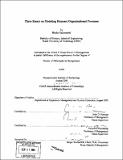Three essays on modeling dynamic organizational processes
Author(s)
Rahmandad, Hazhir
DownloadFull printable version (14.93Mb)
Alternative title
3 essays on modeling dynamic organizational processes
Other Contributors
Sloan School of Management.
Advisor
John D. Sterman and Nelson P. Repenning.
Terms of use
Metadata
Show full item recordAbstract
Essay 1- Effects of Feedback Delay on Learning. Learning figures prominently in many theories of organizations. Understanding barriers to learning is therefore central to understanding firms' performance. This essay investigates the role of time delays between taking an action and observing the results in impeding learning. These delays ubiquitous in real world settings can introduce important tradeoffs between the long-term and the short-term performance. In this essay, four learning algorithms, with different levels of complexity and rationality, are built and their performances in a simple resource allocation task are analyzed. The study focuses on understanding the effect of time delays on learning. Simulation analysis shows that regardless of the level of rationality of the organization, misperceived delays can impede learning significantly. Essay 2- Heterogeneity and Network Structure in the Dynamics of Diffusion: Comparing Agent-Based and Differential Equation Models When is it better to use agent-based (AB) models, and when should differential equation (DE) models be used? (cont.) Where DE models assume homogeneity and perfect mixing within compartments, AB models can capture heterogeneity in agent attributes and in the network of interactions among them. The costs and benefits of such disaggregation should guide the choice of model type. AB models may enhance realism but entail computational and cognitive costs that may limit sensitivity analysis and model scope. Using contagious disease as an example, we contrast the dynamics of AB models with those of the analogous mean-field DE model. We examine agent heterogeneity and the impact of different network topologies, including fully connected, random, Watts-Strogatz small world, scale-free, and lattice networks. Surprisingly, in many conditions differences between the DE and AB dynamics are not statistically significant for key metrics relevant to public health, including diffusion speed, peak load on health services infrastructure and total disease burden. We discuss implications for the choice between AB and DE models, level of aggregation, and model boundary. The results apply beyond epidemiology: from innovation adoption to financial panics, many important social phenomena involve analogous processes of diffusion and social contagion. (cont.) Essay 3- Dynamics of Multiple-release Product Development Product development (PD) is a crucial capability for firms in competitive markets. Building on case studies of software development at a large firm, this essay explores the interaction among the different stages of the PD process, the underlying architecture of the product, and the products in the field. We introduce the concept of the "adaptation trap," where intendedly functional adaptation of workload can overwhelm the PD organization and force it into firefighting (Repenning 2001) as a result of the delay in seeing the additional resource need from the field and underlying code-base. Moreover, the study highlights the importance of architecture and underlying product-base in multiple-release product development, through their impact on the quality of new models under development, as well as through resource requirements for bug-fixing. Finally, this study corroborates the dynamics of tipping into firefighting that follows quality-productivity tradeoffs under pressure. Put together, these dynamics elucidate some of the reasons why PD capability is hard to build and why it easily erodes. (cont.) Consequently, we offer hypotheses on the characteristics of the PD process that increase its strategic significance and discuss some practical challenges in the face of these dynamics.
Description
Thesis (Ph. D.)--Massachusetts Institute of Technology, Sloan School of Management, 2005. Includes bibliographical references.
Date issued
2005Department
Sloan School of ManagementPublisher
Massachusetts Institute of Technology
Keywords
Sloan School of Management.